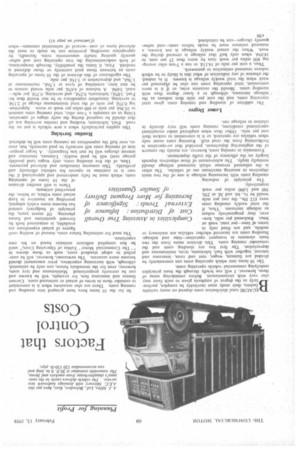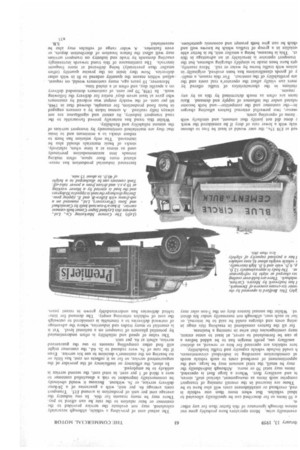Factors that Control Costs
Page 70

Page 73

If you've noticed an error in this article please click here to report it so we can fix it.
ECAUSE total distribution costs depend on many variable factors, their study must inevitably be complex, particu larly as the degree of emphasis given to each facet may also vary with circumstances. Before considering some of these, however, I will run briefly through the basic principles underlying commercial vehicle operating costs.
The 10 items into which operating costs can conveniently be divided. are licences, wages, .rent and rates, insurance and interest, together with fuel, lubricants, tyres, maintenance and depreciation. The first five are standing costs and the remainder running costs. This division stems from the two basic elements in transport operation—time and mileage, Standing costs are incurred whether vehieles are stationary or mobile, and are fixed only in terms time—per year, week or hour. Reckoned per mile, however, they progressively reduce as mileage increases. Thus, if the total weekly standing costs were £12 10s., the cost per mile would be Is., 6d. and 3d. at 250, 500 and 1,000 miles per week respectively.
The principle of reducing standing costs with increasing mileage is one of the two main objectives in securing maximum use of vehicles. The other is the enhanced revenue which increased mileage should normally imply. The achievement of these objectives depends largely on the efficiency of the traffic department.
Economies in running costs, however. are mainly the concern of the engineering department. provided that co-operation is forthcoming from the road staff. Running costs occur only when vehicles are operated, so it is convenient to reckon their cost per mile. Other than when employed under exceptional operational conditions, running costs will vary directly in relation to mileage run.
Lesser Degree
The addition of standing and running costs gives total operating costs, and the cost per mile then reduces as the mileage increases, although to a lesser degree than with standing costs. Should the occasion arise, or if it is more convenient, total operating costs can also be eXpressed per week when the total weekly mileage is known. It is, indeed, the absence of any indication of what this is likely to be which reduces reasoned estimation to guesswork.
Thus, a cost per mile of 14.11d. to run a 7-ton oiler averaging 800 miles per week rises by more than 25 per cent. to I8.09d. when only half that mileage is covered during the week. When the actual weekly mileage is not known, a reasoned estimate must be made before costs—and subsequently charges—can be calculated. So far the 10 items have been grouped into standing and running costs. There are also occasions when it is convenient to consider them in terms of actual or estimated costs. Current licence and insurance fees, for example, will be known and can be correctly proportioned Maintenance and tyre costs, however, even for the immediate future, can only be estimated, although, with increasing experience, prior assessment should become more accurate. The newcomer, however, will be compelled to adopt standard costs, such as those shown in " 'The Commercial Motor' Tables of Operating Costs," until be has compiled sufficient statistics based on his own experience.
The need for estimating future costs, instead of waiting until figures of actual expenditure are available, is occasioned both by forward quotations and future planning. Of recent years, the principle of budgetary control has become more widely adopted, providing an incentive to keep actual costs within, or below, the prescribed estimate.
There is still another division of the 10 items of operating costs, which must be fully understood and appreciated if the user is to continue to operate his vehicles efficiently and profitably. This concerns immediate and deferred payments.
Thus, of the five standing costs, only wages (and possibly garage rent) will be paid weekly. Licences, insurance and interest charges will be met less frequently. A larger proportion of running costs will normally be paid currently, but, even so, over half the expenditure on running costs will he deferred.
Routine Servicing
This applies particularly when a new vehicle is put on the road. Fuel, lubricants, washing and routine servicing are all that should be required during the early stages. of operation. Using as an example a 7-ton oiler, total running costs amount to I0,36d. per mile at 600 miles per week or more. Apportioning 0.37d. per mile of the total maintenance charge of 2.I3d. to servicing, immediate expenditure to be met Would then be: Fuel, 3.07d.: lubricants, 0.25d., and servicing, 0.37d. per mile— total, 3.69d. A balance of 6.67d, per mile would remain to be met later, consisting of tyres at I.76d., maintenance at 1.76d„ and depreciation at 3.15d. per mile.
The significance of this division of the 10 items of operating costs as between those paid currently or those deferred is twofold. First, it limits the possibility, through inexperience, of both underestimating the true operating cost and subsequently quoting totally uneconomic rates. Secondly, by appropriate recording, provision can be made to meet the deferred items of cost—several of substantial amounts—when
eventually arise. More operators have probably gone out isiness through ignorance of this factor than for any other ,n.
e 10 items so far described can be specifically allocated to idual vehicles. But when more than one vehicle is tied, overhead or establishment costs will also have to be These are incurred in the overall running of transport comprise such items as management, clerical staff, stores, ts and auxiliary fleet. Where a large fleet is operated, items may total 50 or more. Although individually the may be small, the total amount may be large. and the apportionment of overhead costs to each vehicle needs ul consideration according to individual circumstances, h could include vehicle capacity and traffic loadability.
.tere vehicles are operated for hire or reward, as distinct ancillary use, profit margin has to be added before a ;e can be formulated to cover, at least to some extent. nany contingencies that arise in running a business.
far all the factors considered in reaching this stage in Luting costs and charges could be said to be internal, or liar to each user, although not necessarily under his direct 731. Whilst the annual licence duty on the 7-ton oiler may
■ ted at £38 15s., the user would at least be free to choose tide with a lower rate of duty if he considered the work done did not justify that amount, and similarly with items of operating costs.
twever, two powerful external factors affecting charges in—the customer and the competitor—and both become related under the influence of supply and demand. Rate tures are often as much determined by this as by any reason.
nations in the characteristics of traffic offered by mers can vitally affect the operator's real costs and the ate profitability of the contract. For this reason, a multiy of goods classifications has been evolved, originally-in :ction with traffic borne by water or rail. More recently, ipts have been made to simplify charging schemes, but the transport operator is invariably at an advantage in this ct. This is because, being a smaller unit, he is better able ecialize in a group of traffics which he knows well and vhich he can give both prompt and economic quotations, The actual cost of preuiding a vehicle, although accurately calculated. may not evaluate the service provided to the customer or bear relation to the rate he can afford to pay. There may be many reasons for this. In one industry the average cost per unit of production is around £15. Transport costs average 6s. per unit, with a guarantee of a 24-hour delivery service, or 5s. without. Because it would obviously be commercially imprudent to risk a dissatisfied customer to save a third of 1 per cent. in total cost, the second service is unlikely to be employed.
In short, the efficiency or inefficiency of the provider of the unguaranteed service, so far as it reflects on cost, has little or no bearing on the customer's decision to use his service. Even if the rate of 5s. were reduced to 2s. 6d., the customer might still find other compelling reasons to use the guaranteed service, albeit at 6s, per unit.
The value of speed and reliability is often underestimated by potential planners of transport on a national level, Yet it is essential to many trades and industries, where the advantage of outward deliveries to a timetable is considered to outweigh the cost of vehicles returning empty. The demand for timetabled deliveries has understandably grown in recent years.
Increased industrial production has necessitated more floor space, often making inroads into accommodation previously used as stores at a time when, relatively. stocks of basic materials should also be increased. The only solution has been to reduce stocks to a minimum and to insist that they are maintained continuously by transport services of the utmost reliability and flexibility.
Whilst this trend has naturally proved favourable to the road transport industry, its extent and significance are not always fully realized. A census taken by a concern engaged in basic food production, for example, showed that in 1948, 60 per cent. of the weekly output was ordered by customers who gave at least seven days' notice for delivery the following week. In 1958, 70 per cent. of customers demanded delivery on a specific day, and often at a stated time.
Moreover, 10 years ago, many customers would, on request, .adjust within reason the quantity ordered to fit in with other deliveries. Now they insist on the precise quantity (often smaller than previously) being delivered at more frequent intervals. The continuance of this trend towards increasingly exacting demands by trade and industry on transport services may well affect the future location of distribution depots, or even factories. A wider range of vehicles may also be
necessitated. S.13,
















































































































